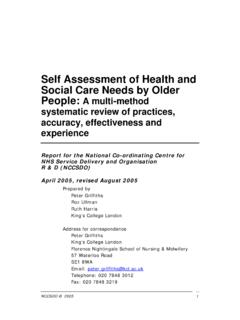Transcription of The impact of leadership factors in implementing …
1 I The impact of leadership factors in implementing change in complex health and social care environments: NHS Plan clinical priority for mental health crises resolution teams. The research was undertaken by Professor Beverly Alimo"Metcalfe (Principal Investigator)* Dr John Alban"Metcalfe* Dr Chiara Samele** Margaret Bradley * Dr Jeevi Mariathasan** With contributions from Juliette Alban"Metcalfe* Dr Jayne Camara** Ines Garcia ** Angela Greatley** Nadia Nagamoottoo* Rachael Straw* * Real World Group (a University of Leeds spin"out company) ** King s College London Sainsbury Centre for Mental Health i Contents Page Acknowledgements i Executive Summary ii-xii Section 1.
2 leadership and Organisational Climate 1 Section 2: Development of Crisis Resolution/Home 69 Treatment Teams Section 3: Rationale 78 Section 4: Methodology 83 Section 5: Results 1: Quantitative Analysis 97 Section 6: Results 2: Case Studies 132 Section 7: Discussion 227 References 249 Appendices Appendix 1: The leadership Culture and Change Inventory 271 Appendix 2: Analysing Change Questionnaire 279 Appendix 3: Case Study Topic Guide 295 Appendix 4: Hierarchical Multiple Regression 297 i Acknowledgements The research was funded by NHS Service Delivery and Organisation Programme Research & Development grant SDO/22/2002.
3 The authors with to express their gratitude to members of the SDO, in particular Dr Stuart Anderson and Barbara Langridge, for their continuing encouragement and support. The hierarchical multiple regression analyses and structural equation modelling were undertaken by Dr Neil Conway of Birkbeck College, to whom we wish to express sincere thanks. Sincere thanks as also due to Iain Ryrie, Dr Richard Ford and Dr Matt Muijen, who put together the initial proposal, and to Professor Brian Everitt, Emeritus Professor of Statistics at King s College who undertook preliminary statistical analyses of the data, and who advised on the initial research design. The contribution of the members of the Steering Group: Tom Dodd, Jen Kilyon, Les Mitchell, Professor Steve Onyett, and Joan Penrose was greatly valued, and the comments and suggestions they made were much appreciated.
4 We would also wish to express our gratitude both to the members of the teams who generously gave up their time to participate in the project, and without whom the research could not have been undertaken, and to the three anonymous reviewers for their valuable comments and suggestions. ii EXECUTIVE SUMMARY In summarising the findings of this national, longitudinal study of the relationship between quality of leadership in Mental Health Crisis Resolution Teams (CRTs) and both staff attitudes and well"being, and organisational performance, we would like to address three principal questions: What did we set out to achieve? What did we find? What are the implications?
5 What did we set out to achieve? 1. The development of CRTs over the past decade, and the policy initiatives to mainstream these crises services across England, presented an ideal backdrop against which to examine policy implementation and the impact of leadership on the functioning and performance of these teams. Consistent with the Department of Health Mental Health Policy Implication Guidelines (MHPIG), the teams were selected with reference to the Durham Mapping database, such that they: " were multi"professional in their composition; operated 24/7, 365 days of the year; and delivered services in the patient s home or community.
6 The additional inclusion criterion of being in operation for at least 6 months was imposed. 2. The purpose of the investigation was to undertake longitudinal research to examine the relationship between quality of leadership and both staff attitudes to work and their well"being at work, and organisation performance, allowing for the effect of a wide range of contextual factors . 3. This was achieved through collection of a combination of quantitative and qualitative data, including 8 detailed Case Studies. 4. The principal hypothesis was: that the quality of leadership exhibited by CRTs is directly related to team effectiveness. Team effectiveness, which was defined in two ways: (1) staff attitudes to work and sense of well"being at work; (2) organisational performance, was tested through a series of subordinate hypotheses.
7 5. Complete data were available for a total of 46 mental health crisis resolution teams (CRTs) from different parts of England. Review of the literature 6. In order to ensure that an appropriate model of leadership was adopted, an extensive review was undertaken of the relevant literature. iii Our understanding of the history of the formal academic research into the nature of leadership is that it can be seen to have developed through 5 main stages: the trait or Great Man approach; the behavioural approach, out of which the concept of managerial and later leadership competencies emerged; the situation or contingency approach; the new paradigm approach, with its focus on distant transformational, often heroic leadership ; and finally, the emergence of nearby transformational or engaging; leadership , and the associated concept of distributed leadership .
8 7. It was suggested that it is valuable to distinguish two aspects of leadership what a leader does, and how they do it. The first of these, as exemplified by the NHS leadership Qualities Framework , the police Integrated Competency Framework , and the fire and rescue service Personal Qualities and Attributes , can be seen to reflect leadership competency, which may be defined as follows: A competent leader is someone who enables the development of an organisation in a way that is goal directed, and geared to developing processes and systems. This enables staff at all levels to plan effectively and efficiently, in order to achieve agreed goals. High levels of competency can lead to a degree of consistency within an organisation or department, and thereby enable staff to make day-to-day decisions and short-term predictions, with a measure of confidence.
9 leadership competencies, which are often largely closed"ended in nature, are necessary in order that staff can undertake both strategic and day-to-day planning, and in this way help to turn the vision of an organisation, department or team into a reality. The second of these may be defined in the following way: A transformational or engaging leader is someone who encourages and enables the development of an organisation that is characterised by a culture based on integrity, openness and transparency, and a genuine valuing of others. This shows itself in concern for the development and well-being of others, in the ability to unite different groups of stakeholders in articulating a joint vision, and in delegation of a kind that enables and develops potential, coupled with the encouragement of questioning and of thinking which is critical as well as strategic.
10 Engaging leadership is essentially open"ended in nature, enabling organisations not only to cope with change, but also to iv be proactive in shaping their future. At all times, nearby transformational behaviour is guided by ethical principles. Recent research in the US, UK and more widely, has pointed to the significant impact of an engaging style of leadership on organisational performance among a wide range of medium to large"size companies. Research conducted in the NHS and local government in the UK, (and replicated in FTSE 100 companies) that was inclusive of gender, ethnicity, and level, has provided a robust metric, of proven validity, for assessing this kind of leadership behaviour.










